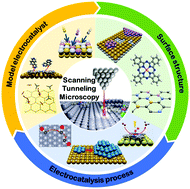Insights into electrocatalysis by scanning tunnelling microscopy
Abstract
Understanding the mechanism of electrocatalytic reaction is important for the design and development of highly efficient electrocatalysts for energy technology. Investigating the surface structures of electrocatalysts and the surface processes in electrocatalytic reactions at the atomic and molecular scale is helpful to identify the catalytic role of active sites and further promotes the development of emerging electrocatalysts. Since it was invented, scanning tunnelling microscopy (STM) has become a powerful technique to investigate surface topographies and electronic properties at the nanoscale resolution. STM can be operated in diversified environments. Electrochemical STM can be used to investigate the surface processes during electrochemical reactions. Moreover, the critical intermediates in catalysis on catalyst surfaces can be identified by STM at low temperature or ultrahigh vacuum. STM has been extensively utilized in electrocatalysis research, including the structure–activity relationship of electrocatalysts, the distribution of active sites, and surface processes in electrocatalytic reactions. In this review, progress in the application of STM in electrocatalysis is systematically discussed. The construction of model electrocatalysts and electrocatalytic systems are summarized. Then, we present the STM investigation of electrocatalyst structures and surface processes related to electrocatalysis. Challenges and future developments in the field are discussed in the outlook.



 Please wait while we load your content...
Please wait while we load your content...